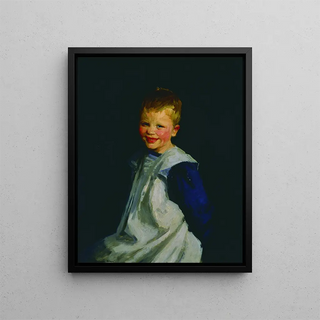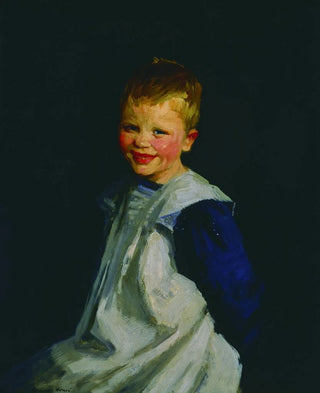Art print | Dutch girl laughing - Robert Henri Source: Reproduction | Fille hollandaise qui rit - Robert Henri


View from behind

Frame (optional)
In the fascinating world of early 20th-century American painting, the art print "Dutch Girl Laughing" by Robert Henri stands out for its vibrancy and expressiveness. This canvas, capturing the carefree and joyful spirit of a young girl, transports us to a world where light and color meet to create a warm and intimate atmosphere. Henri, a prominent member of the Ashcan School movement, mastered the art of immersing himself in urban life while celebrating the beauty of simple moments. The depiction of this young Dutch girl, with her radiant smile and sparkling eyes, embodies the spirit of the era and the authenticity of genre portraits.
Style and uniqueness of the work
Robert Henri's style is characterized by a vibrant realism, where each brushstroke seems animated by palpable energy. In "Dutch Girl Laughing," the artist employs a palette of warm, luminous colors, creating a visual harmony that immediately draws the eye. The impasto technique, which involves applying thick layers of paint, gives the canvas a rich, tactile texture. The delicate sketches of the girl's face reveal a deep understanding of the human soul. Henri does not merely depict a figure; he captures an emotion, a fleeting moment of pure happiness. Light plays a crucial role in this piece, illuminating the girl's face and emphasizing her smile, reinforcing the idea that beauty resides in the simplicity of everyday life.
The artist and his influence
Robert Henri, born in 1865, is often regarded as a pioneer of modern realism. As a leader of the Ashcan School, he sought to portray life as it is, far from the academic ideals of his time. His influence is felt not only in his artistic approach but also in his philosophy of art. Henri encouraged his contemporaries to explore urban life and draw inspiration from ordinary people, street scenes, and daily moments. His teachings shaped a generation of artists who embraced the realism movement and aimed to capture the truth of the

Matte finish

View from behind

Frame (optional)
In the fascinating world of early 20th-century American painting, the art print "Dutch Girl Laughing" by Robert Henri stands out for its vibrancy and expressiveness. This canvas, capturing the carefree and joyful spirit of a young girl, transports us to a world where light and color meet to create a warm and intimate atmosphere. Henri, a prominent member of the Ashcan School movement, mastered the art of immersing himself in urban life while celebrating the beauty of simple moments. The depiction of this young Dutch girl, with her radiant smile and sparkling eyes, embodies the spirit of the era and the authenticity of genre portraits.
Style and uniqueness of the work
Robert Henri's style is characterized by a vibrant realism, where each brushstroke seems animated by palpable energy. In "Dutch Girl Laughing," the artist employs a palette of warm, luminous colors, creating a visual harmony that immediately draws the eye. The impasto technique, which involves applying thick layers of paint, gives the canvas a rich, tactile texture. The delicate sketches of the girl's face reveal a deep understanding of the human soul. Henri does not merely depict a figure; he captures an emotion, a fleeting moment of pure happiness. Light plays a crucial role in this piece, illuminating the girl's face and emphasizing her smile, reinforcing the idea that beauty resides in the simplicity of everyday life.
The artist and his influence
Robert Henri, born in 1865, is often regarded as a pioneer of modern realism. As a leader of the Ashcan School, he sought to portray life as it is, far from the academic ideals of his time. His influence is felt not only in his artistic approach but also in his philosophy of art. Henri encouraged his contemporaries to explore urban life and draw inspiration from ordinary people, street scenes, and daily moments. His teachings shaped a generation of artists who embraced the realism movement and aimed to capture the truth of the






